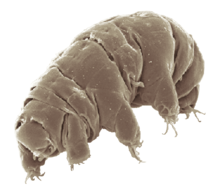| Tardigrade Temporal range:
Middle Cambrian stem-group fossils
| |
|---|---|

| |
| Milnesium tardigradum, a eutardigrade | |

| |
| Echiniscus insularis, a heterotardigrade | |
| Scientific classification | |
| Domain: | Eukaryota |
| Kingdom: | Animalia |
| Subkingdom: | Eumetazoa |
| Clade: | ParaHoxozoa |
| Clade: | Bilateria |
| Clade: | Nephrozoa |
| (unranked): | Protostomia |
| Superphylum: | Ecdysozoa |
| (unranked): | Panarthropoda |
| Phylum: | Tardigrada Spallanzani, 1777 |
| Classes | |
| |
Tardigrades (/ˈtɑːrdɪɡreɪdz/ ),[1] known colloquially as water bears or moss piglets,[2][3][4][5] are a phylum of eight-legged segmented micro-animals.[2][6] They were first described by the German zoologist Johann August Ephraim Goeze in 1773, who called them Kleiner Wasserbär 'little water bear'.[7][8] In 1776, the Italian biologist Lazzaro Spallanzani named them Tardigrada (/tɑːrˈdɪɡrədə/ ), which means 'slow steppers'.[9][10]
They have been found in diverse regions of Earth's biosphere – mountaintops, the deep sea, tropical rainforests, and the Antarctic.[10] Tardigrades are among the most resilient animals known,[11][12] with individual species able to survive extreme conditions – such as exposure to extreme temperatures, extreme pressures (both high and low), air deprivation, radiation, dehydration, and starvation – that would quickly kill most other known forms of life.[13] Tardigrades have survived exposure to outer space.[14][15] There are about 1,300 known species[16] in the phylum Tardigrada, a part of the superphylum Ecdysozoa consisting of animals that grow by ecdysis (shedding an exoskeleton) such as arthropods and nematodes. The earliest known true members of the group are known from Cretaceous (145 to 66 million years ago) amber, found in North America, but are essentially modern forms. Their origin is therefore likely much earlier, as they diverged from their closest relatives in the Cambrian more than 500 million years ago.
Tardigrades are usually about 0.5 mm (0.020 in) long when fully grown.[2] They are short and plump, with four pairs of legs, each ending in claws (usually four to eight) or suction disks.[2][17] Tardigrades are prevalent in mosses and lichens and feed on plant cells, algae, and small invertebrates. When collected, they may be viewed under a low-power microscope, making them accessible to students and amateur scientists.[18]
- ^ "tardigrade". Dictionary.com Unabridged (Online). n.d.
- ^ a b c d Miller, William (2017-02-06). "Tardigrades". American Scientist. Retrieved 2018-04-13.
- ^ Simon, Matt (21 March 2014). "Absurd Creature of the Week: The Incredible Critter That's Tough Enough to Survive in the vacuum of Space". Wired. Retrieved 2014-03-21.
- ^ Copley, Jon (23 October 1999). "Indestructible". New Scientist. No. 2209. Retrieved 2010-02-06.
- ^ "Stanford Tardigrade Project". Foldscope. 2016-08-10. Retrieved 2017-03-23.
- ^ Dean, Cornelia (September 9, 2015). "Meet tardigrade, the water bear". The Hindu. Retrieved August 9, 2019.
- ^ Greven, Hartmut (2015). "About the little water bear: A commented translation of GOEZE'S note "Ueber den kleinen Wasserbär" from 1773". Acta Biologica Benrodis. 17: 1–27. Retrieved 27 September 2024.
- ^ Cross, Ryan (2016-11-07). "Secrets of the tardigrade". C&EN Global Enterprise. 94 (44): 20–21. doi:10.1021/cen-09444-scitech1. Retrieved 31 May 2021.
- ^ Spallanzani, Lazzaro (2015-10-04). "Opuscoli di fisica animale, e vegetabile - Google Libros". Retrieved 2024-09-27.
- ^ a b Bordenstein, Sarah. "Tardigrades (Water Bears)". Microbial Life Educational Resources. National Science Digital Library. Retrieved 2014-01-24.
- ^ Guarino, Ben (14 July 2017). "These animals can survive until the end of the Earth, astrophysicists say". The Washington Post. Retrieved 14 July 2017.
- ^ Sloan, David; Alves Batista, Rafael; Loeb, Abraham (2017). "The Resilience of Life to Astrophysical Events". Scientific Reports. 7 (1): 5419. arXiv:1707.04253. Bibcode:2017NatSR...7.5419S. doi:10.1038/s41598-017-05796-x. PMC 5511186. PMID 28710420.
- ^ Orellana, Roberto; Macaya, Constanza; Bravo, Guillermo; Dorochesi, Flavia; Cumsille, Andrés; Valencia, Ricardo; Rojas, Claudia; Seeger, Michael (2018-10-30). "Living at the Frontiers of Life: Extremophiles in Chile and Their Potential for Bioremediation". Frontiers in Microbiology. 9: 2309. doi:10.3389/fmicb.2018.02309. ISSN 1664-302X. PMC 6218600. PMID 30425685.
- ^ "'Water Bears' are first animal to survive vacuum of space". New Scientist. Archived from the original on 10 September 2008. Retrieved 10 September 2008.
- ^ "'Water Bears' Able To Survive Exposure To Vacuum Of Space". Science Daily. Archived from the original on 11 September 2008. Retrieved 10 September 2008.
- ^ Degma, Peter; Bertolani, Roberto; Guidetti, Roberto (2021). "Actual checklist of Tardigrada species (2009–2021, 40th Edition: 19-07-2021)" (PDF). Università di Modena e Reggio Emilia. doi:10.25431/11380_1178608. Retrieved 2023-12-10.
- ^ Nelson, Diane (1 July 2002). "Current status of Tardigrada: Evolution and Ecology". Integrative and Comparative Biology. 42 (3): 652–659. doi:10.1093/icb/42.3.652. PMID 21708761.
- ^ Shaw, Michael W. "How to Find Tardigrades". Tardigrade USA. Archived from the original on 10 February 2014. Retrieved 2013-01-14.